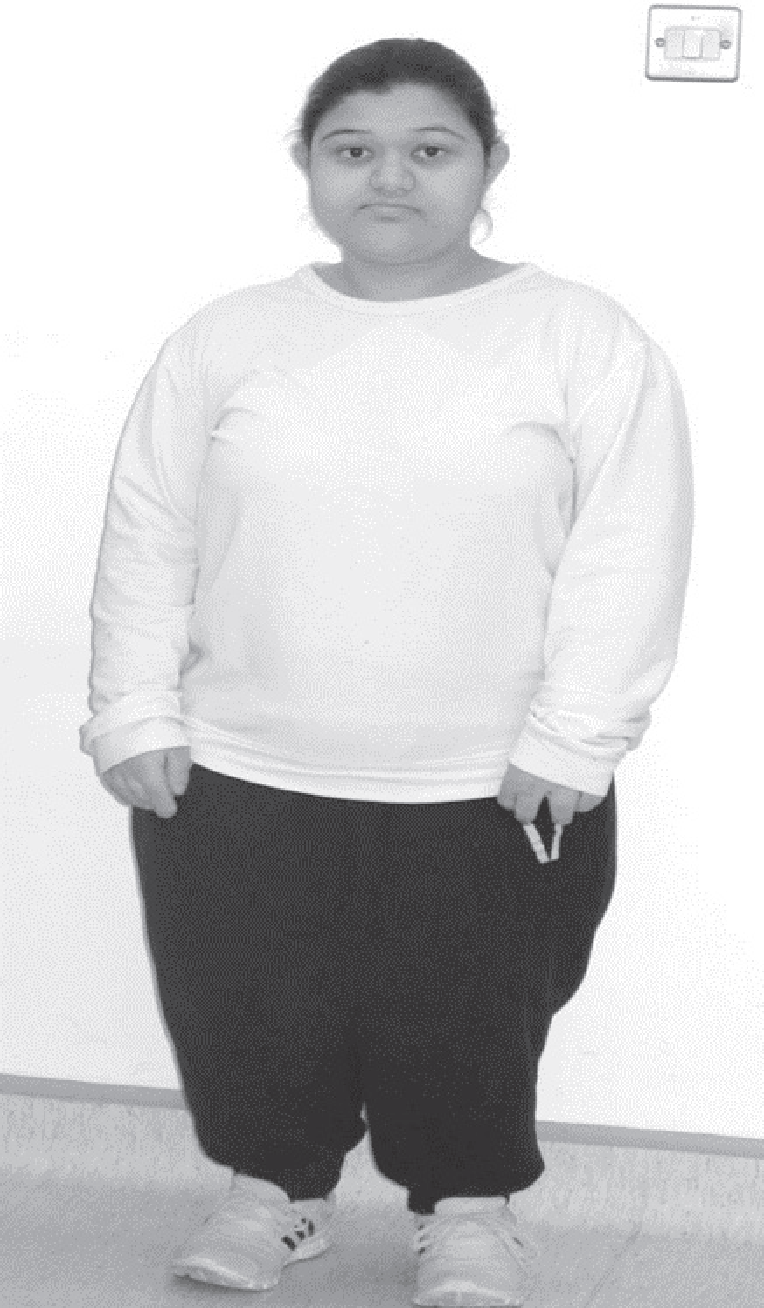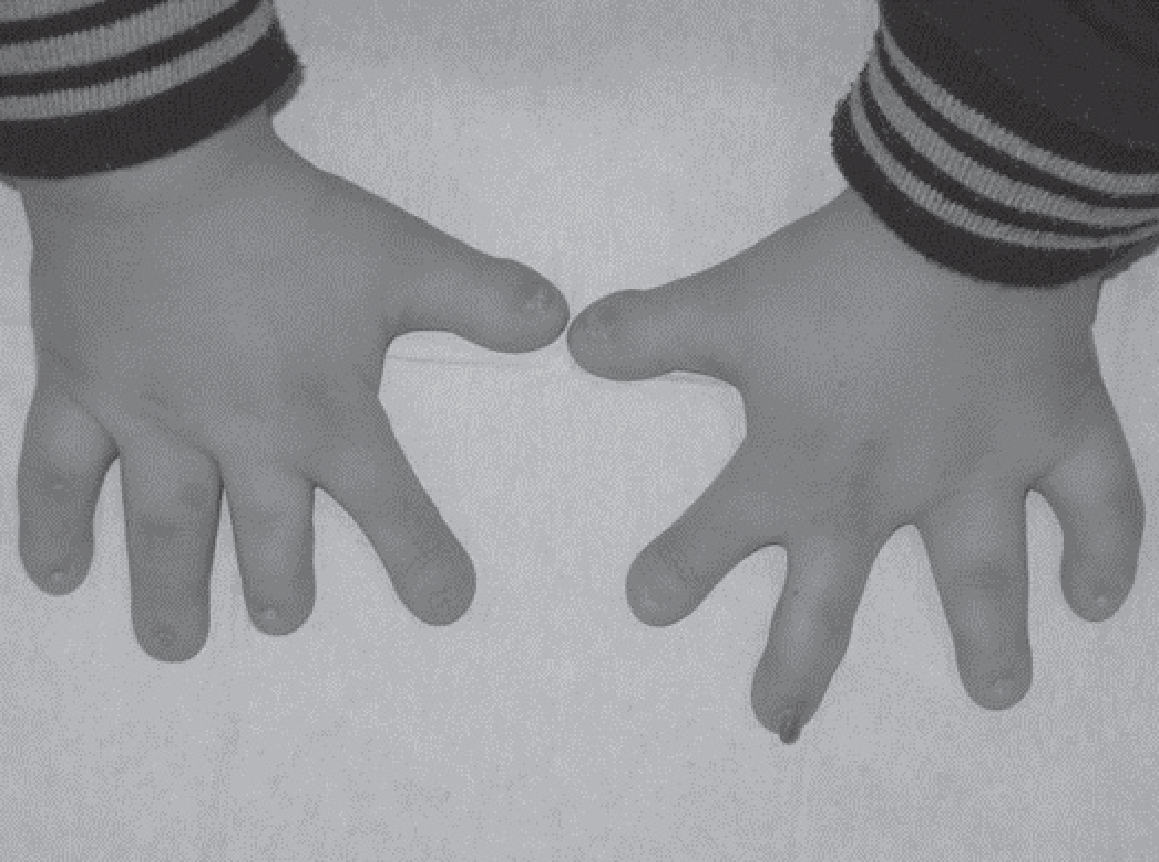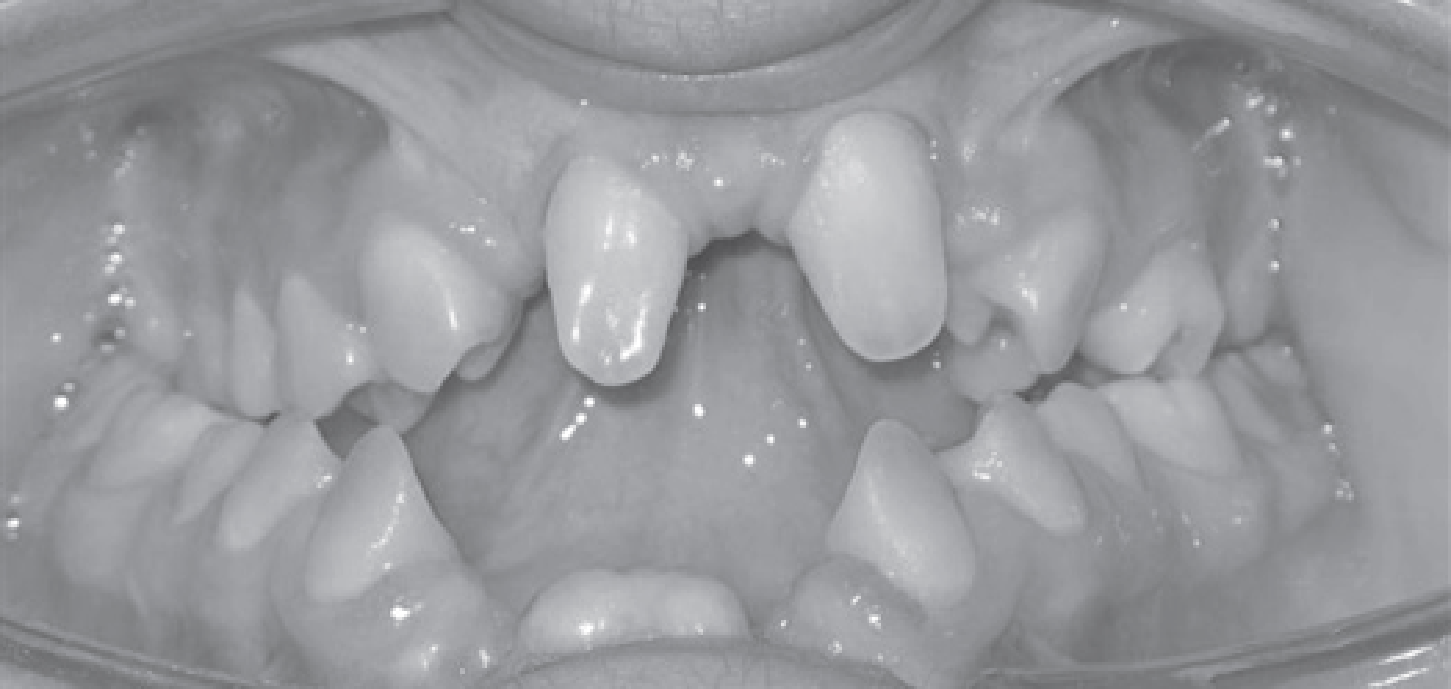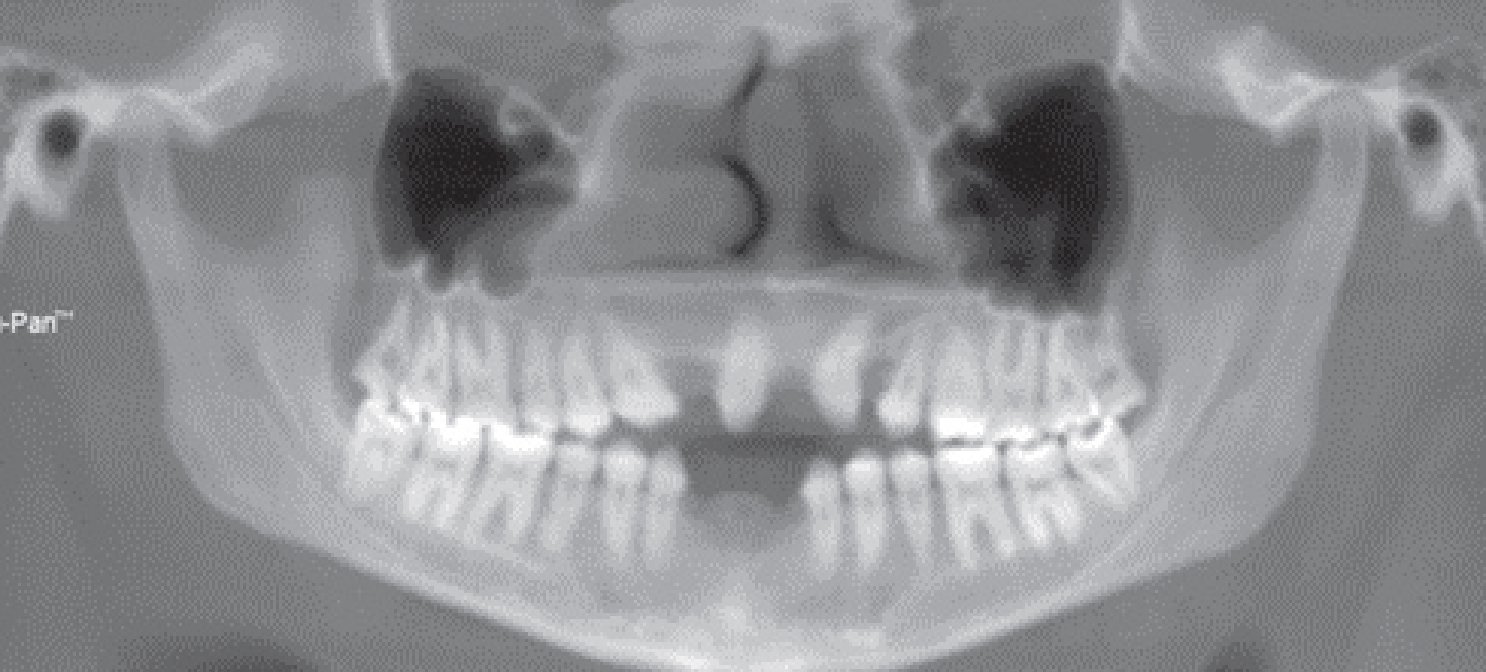Abstract
Ellis-Van Creveld Syndrome, also known as chondroectodermal dysplasia, is a complex genetic disorder caused by a mutation of particular genes. Its main physiological characteristics are dwarfism, polydactyly (additional figures or toes), abnormal nail structure, and dental malformations. In addition, patients with Ellis-Van Creveld Syndrome may have heart defects that cannot be visually identified without specific diagnostic tools. Dental manifestations include enamel hypoplasia and hypodontia. The exact prevalence of this disorder remains poorly investigated because the majority of risk groups are the Amish population that does not share personal information voluntarily. In this report, an eighteen-year-old girl is presented with her chief complaint of poor appearance of teeth. Her dental history includes the exfoliation of mandibular natal teeth, ventricular hypertrophy, and epilepsy. The first-line treatment was offered at the age of seven, and regular check-ups and orthodontic manipulations were made within the last ten years. This case proves the importance of radiographic and physical examination, along with the cooperation of dentists, surgeons, anesthetists, and cardiologists.
Introduction
Ellis-Van Creveld Syndrome is a rare and complex genetic disorder that is usually characterized by the presence of additional fingers or toes, abnormal development of nails and teeth, and skeletal transformations. The main cause of this disorder is a mutation of genes (EVC1 and EVC2, in particular). The first case was reported by Ellis and van Creveld in 1940 and termed as chondroectodermal dysplasia or meso-ectodermal dysplasia. As a genetic disorder, Ellis-Van Creveld Syndrome was thoroughly studied among siblings and relatives to identify common (partial hare lip and partial anodontia) and distinctive (extra fingers or toes) features and symptoms. Its prevalence varies from 1 to 7 in one million in the general population, but some communities (Amish) do not always report on this disorder officially, and all the cases remain poorly investigated. In this report, the attention will be paid to one particular patient in order to investigate the main signs, family history, diagnostic and assessment techniques, and available treatment plans for Ellis-Van Creveld Syndro
Case Presentation
An eighteen-year-old girl reported to the Orthodontics clinic complaining of the poor appearance of upper teeth. She is the 6th child born and the third baby born diagnosed with Ellis-van Creveld Syndrome her elder brother was diagnosed with Ellis-van Creveld syndrome and died after birth, her parent is consanguineous.
History
She had mandibular natal teeth that were exfoliated after 3 months, in addition she had polydactyly (multiple supernumerary fingers) which were surgically removed immediately after birth. The child was kept in the neonatal intensive care unit for 40 days under observation due to ventricular hypertrophy, furthermore the patient was diagnosed with epilepsy when she was younger and was kept under medication for 8 months, no further signs of epilepsy noticed. Her first visit to the dental and maxillofacial center was in 2008 at the age of 7 years. The patient was detected with multiple primary carious teeth as well as hypodontia. The carious teeth were restored while some primary mobile teeth were extracted.
Examination
The patient’s clinical features were characterized by dwarfism, hypoplastic nails, short ribs and facial asymmetry slightly to the left… TMJ….. presented with moderate skeletal base with competent lip and increased lower facial height. An intraoral examination revealed that she has hypodontia with missing mandibular right and left central and lateral incisors as well as maxillary right lateral incisor and left central incisors. She has retained deciduous maxillary left lateral incisors and mandibular right lateral incisors, furthermore the patient has a peg shaped maxillary right central incisor while upper right canine has a talon cusp. She has wide maxillary and mandibular labiogingival frenulum, prominent lower anterior edentulous ridge, average overbite complete to tooth and a reverse overjet of 3mm. In addition, there is palatal displacement of maxillary left second premolar and class III incisor relationship, canine relationship and molar relationship. The patient was seen by the orthodontist at age of 17 years old in 2018 for evaluation of her dentition and advised to follow up routinely with orthodontic clinic and to plan for orthognathic surgery. All her third molars were extracted in 2019 under general anesthesia by a team comprising of an oral surgeon combined with a cardiologist and an anesthetist.
Radiographic Features
A dental panoramic tomography taken in 2015 shows that the patient had all permanent teeth except the mandibular left and right central and lateral incisor and maxillary right lateral incisor, which were missing. She had over-retained mandibular right deciduous lateral incisor with retained maxillary left deciduous lateral incisor. A dental follicle in the location of lower right third molar is seen and its radiographic appearance is suggestive of malformation of the lower right third molar. A lateral cephalometric radiograph was taken in 2019; it shows class III incisor relationship on moderate skeletal base with increased lower facial height as described previously. A Cone-beam computed tomography (CBCT) was done in 2019. It revealed the presence of all permanent teeth except the mandibular left and right central and lateral incisors and the maxillary right lateral incisor. There were retained maxillary left deciduous lateral incisor and mandibular right deciduous lateral incisor. It also showed the lower edentulous area in mandibular incisor area, malformed upper right central incisor, occlusal radio-opacity of maxillary right first molar suggestive of a dental amalgam restoration.
Treatment
At the age of 7 years, the first line of treatment was performed for the patient at the pedodontics clinic and followed up by the general dental practitioner for prevention of dental caries and to improve oral hygiene and dietary analysis. At the age of 17 years, orthodontic treatment was initiated for the patient after risk and benefits were explained to her and she is still undergoing orthodontic fixed appliances at the time of writing this case report. The treatment for her case involves a combination of restorative treatment for malformed right central incisor and restoration of deciduous teeth to appear like permanent teeth with prosthetic treatment for replacement of missing teeth, concluding with orthognathic surgery by the maxillofacial surgeon.
Discussion
The complexity of Ellis-Van Creveld Syndrome is explained by the presence of a number of physiological changes in patients. In the majority of cases, the symptoms of this disorder can be observed during the first physical examination of a child or during the gestational period. The changes include the presence of extra fingers, also known as polydactyly, dwarfism (see figure 1), nail hypoplasia (see figure 2), and facial abnormalities like asymmetry to the right or to the left. The main diagnostic tools include radiological prenatal ultrasound (during the gestational period) or a panoramic radiograph that can be offered directly to the patient. Communication with the patient or their official caregivers provides a good opportunity to study family history and dental changes that have already been observed and treated. Certain cardiovascular problems are detected in about 50% of patients, and chest X-rays, electrocardiography, and electrocardiograms are recommended to analyze possible malformations and to offer a treatment plan. Sometimes, children are not able to detect the sources of pain and explain to their parents or doctors what bothers them, how often or how hard painful accidents occur.
In addition to the abnormal condition of extremities or visual facial expression, it is important to check all dental malformations and abnormalities. People with Ellis-Van Creveld Syndrome usually have hypodontia with several maxillary lateral incisors, mandibular central and lateral incisors being missed (see figure 3). To fully assess the condition of the mouth, doctors apply to the results of the dental panoramic tomography (see figure 4). This method shows that patients with the syndrome under consideration could have all permanent teeth, but the maxillary lateral incisors and canines are absent or removed in childhood. During the examination, the patient with polydactyly or dwarfism should also consider the possibility of such differential diagnoses as Majewski Syndrome, Beemer-Langer Syndrome, Saldino-Noonan Syndrome, and Asphyxiating Thoracic Dystrophy. If no infection or heart-related problems are observed, antibiotics may be omitted. Still, patient education and prevention strategies play a critical role. People have to visit dental clinics regularly and check the condition of their teeth. The main principles of oral hygiene and the analysis of dietary habits, and fluoride varnish application are optional preventive interventions. Orthodontic treatment remains the major element of dental health care.




Conclusion
The management of care for patients with Ellis-Van Creveld Syndrome turns out to be a complex task for many orthodontic clinics and healthcare facilities. This disorder has a complex nature and is characterized by a number of physiological changes, including facial expression, extremity abnormalities, heart-related problems, and associated emotional concerns. Families, where at least one person is diagnosed with Ellis-Van Creveld Syndrome, are in the risk group because this disorder is genetic, and a mutation in genes are hard to predict or controlled. The majority of studies are developed to provide people with enough credible information but not to explain how to predict this disorder. With the help of available diagnostic tools, examination guidelines, and professionals of healthcare workers, it is possible to reveal other problems and identify the most effective treatment. Serious dental diseases provoked by Ellis-Van Creveld Syndrome may be controlled by following simple oral hygiene and dietary recommendations.
References
- Al Qooz, FS, Al Ghatam, R. Ellis-Van Creveld syndrome. Bahrain Med Bull. 2018; 40(4): 242-44.
- Das AC, Azad MT, Chowdhury JF. Ellis-Van Creveld syndrome: a case report. Bangladesh J Child Health. 2016;40(3):179-82.
- Gokulraj S, Mohan N, Raj JB, et al. Ellis-Van Creveld syndrome in siblings: a rare case report. J Pharm Bioall Sci. 2016;8(1):179-81.
- Guiguimdé WP, Agoda P, Bationo R, et al. Oral manifestations in Ellis-Van Creveld syndrome: a case report. J Oral Med Oral Surg. 2018;24(2):76-80.
- Khan I, Ahmed SA, Mohsin K. Ellis-Van Creveld syndrome: a case report. J Pak Med Assoc. 2017;16(4):239-42.Nazemisalman B, Salah S, Vahabi S, Nabtieh A. Oral Ellis-Van Creveld syndrome: a brief review of literature and a case report. J Dent Oral Implants. 2017;1(4).
- Hirachan A, Bishal KC, Maskey A, et al. Late presentation of Ellis-Van Creveld syndrome with common atrium anomaly: a case report in a Nepalese adult. J Adv Intern. Med. 2018;7(1):26-9.
- Nazemisalman B, Salah S, Vahabi S, Nabtieh A. Oral Ellis-Van Creveld syndrome: a brief review of literature and a case report. J Dent Oral Implants. 2017;1(4). Web.
- Naqash TA, Alshahrani I, Simasetha S. Ellis-Van Creveld syndrome: a rare clinical report of oral rehabilitation by interdisciplinary approach. Case Rep Dent. 2018; 2018. Web.
- Katti S, Oswal P, Vas A. Ellis-Van Creveld syndrome: a rare case report. J Interdiscip Dent. 2019;9(1):35-8.
- Peña-Cardelles JF, Domínguez-Medina DA, Cano-Durán JA, et al. Oral manifestations of Ellis-Van Creveld syndrome: a rare case report. J Clin Exp Dent. 2019;11(3):290-5.